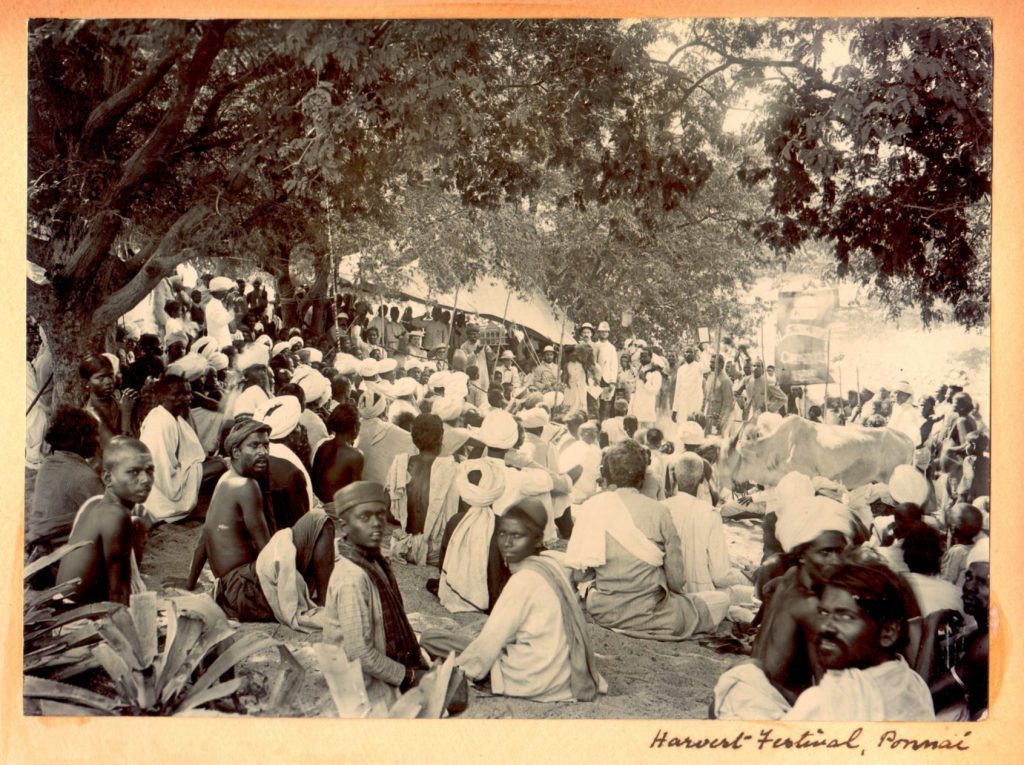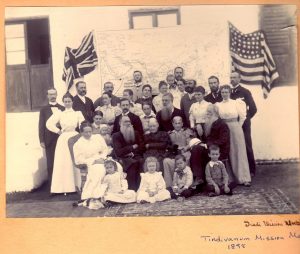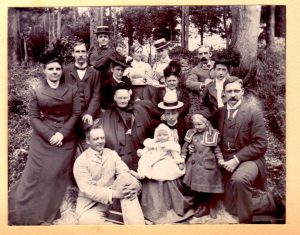1000 Years of Service
John Scudder was the first of the Scudders to come to India. He was certainly not the last. Soon other Scudders and their descendants began a tradition of service. All told, the family has over 1000 years of service.
David Coit Scudder
Born on October 27, 1835, at Boston, Mass., the son of Charles and Sarah Lathrop (Coit) Scudder. He is not descended from John Scudder, but rather from a Scudder of the early days of the Massachusetts Bay Colony.
He was an American missionary influenced in boyhood to go to India by the work of Rev. Dr. John Scudder, Sr. Scudder arrived at Madras on June 26, 1861. He was in charge of the large .station of Periyakulam. He was admired by the Christians of the large village congregations of that station.
David Scudder drowned at age 27, in the Vaigai River November 19,1862, 20 months after arriving in Tamil Nadu. Interment was in the old Anglican Churchyard, at Kodikanal.
Second generation
Henry Martyn Scudder, M.D., D.D. (1822–95) was an American missionary and minister. He was born at Panditeripo, Ceylon, the oldest child of Rev. Dr. John Scudder. He graduated from the University of the City of New York in 1840 and Union Theological Seminary in 1843. The following year he went as missionary to Madurai, India, and in 1846 to Madras. He labored successively at organizing schools and churches in Madras, Arcot, Vellore, Coonoor, and Ootacamund (Udhagamandalam). In 1850 he founded the mission at Arcot for the board of the Dutch Reformed Church and in 1851 he opened the Wallajapet Dispensary. Having studied medicine, he also practised that profession. 1853 the dispensary moved to Ranipet because it was more central and strategic in location. In 1854 dispensary was closed due to serious illness of H. M. Scudder who went to the hills for recuperation.[11]
He prepared various religious books and tracts in the Sanskrit, Tamil, and Telugu languages. His publications include “Liturgy of the Reformed Protestant Dutch Church” (Madras, India, 1862); “The Bazaar Book, or the Vernacular Teacher’s Companion” (1865); “Sweet Savors of Divine Truth,” a catechism (1868) ; and “Spiritual Teaching” (1870). These are all in the Tamil language.
In 1856 Madurai united with the other American Tamil missions in appointing Henry Scudder as their representative to a convention held in Madras to adopt measures for the new Tamil Bible revision.
In 1864, his health failing in the climate of India, he returned to the United States and engaged in pastoral work for nearly 20 years. He was pastor of the Howard Presbyterian church in San Francisco, California, in 1865-’71, of the Central Congregational church in Brooklyn in 1872-’82, and from 1882 till 1887 of the Plymouth Congregational church, Chicago, from which he resigned to resume missionary work in Japan till 1889.
Rev. William Scudder born about 1826, gave twenty-two years of service to India, was then a congregational pastor for eleven years in America. When he was sixty years old he went back to India for nine years of labour, and died in 1895.[12]
Jared Waterbury Scudder, M.D., D.D. was born in Panditeripo, Ceylon, in 1830, was graduated from Western Reserve College[disambiguation needed] in 1850, and the New Brunswick Theological Seminary in 1855. He was ordained a missionary to India under the Reformed Dutch church. He joined Arcott Mission in 1855 and from 1857 held native charges there. He published Tamil translations of Henry M. Scudder’s Spiritual Teaching (Madras, 1870), Bazaar Book (1870), and History of the Arcot Mission (1872). He was a member of the committee for the revision of the Tamil translation of the Bible.
Silas Downer Scudder, born in Ceylon, November 6, 1833. He graduated from Rutgers University in 1856, studied medicine, and was licensed to practise in New York city. Dr. Silas Downer Scudder was requested by the Arcot mission and his brothers to come and start medical work in Ranipet and in 1860 he went to India as a medical missionary and settled at Arcot. There he founded a dispensary and hospital supported by English and native residents. He also successfully treated a large native out-door practice, and obtained patients among high-caste Hindu women, who previously would not see an American doctor.
On March 17, 1866, Ranipet Hospital opened. Due to its high standard of practice, the Madras government closed the civil dispensary and “handed over its buildings ,furniture and stock in hand together with half the amount of money allowed to the dipensary”, to Dr. Silas Scudder stipulating only that an annual report be submitted. At this time the dispensary and hospital were free to all and inpatients were provided with bedding, clothes and food as well as all treatment and medicines free of charge.
In 1872, Dr. John Scudder II took charge of the Ranipet Hospital and its evangelistic work from his elder brother Dr. Silas Downer Scudder because of the Arcot Mission’s action.[11] After thirteen years’ labor for the American board, he returned to New York because of illness. He died in Brooklyn, New York, December 10, 1877.
William Waterbury Scudder, born 1835 at Panditeripo, Ceylon, D.D., joined Arcott Mission 1852, retired 1894, buried at Kodaikanal in 1900.[13]
Joseph Scudder, M.D., D.D., joined Arcot Mission 1853, died 1860
Ezekial Carman Scudder, M.D., D.D. Missionary, joined Arcot Mission 1855, retired 1876
Harriet Scudder joined Arcot Mission 1854, retired 1856
Louisa Scudder joined Arcot Mission 1855, retired 1861
Rev. Dr. John Scudder Jr. M.D., D.D., was the youngest son of John Scudder Sr. He Sailed to India with his wife, Sophia Weld, in 1860. He joined Arcott Mission in 1861 and died in 1900. Three of his children, including Dr. Ida S. Scudder, became missionaries.
Third generation
In 1877, Dr. Henry Martyn Scudder Jr. started the Maternity Department at Ranipet. In 1880, he resigned from the Arcot Mission and departed to the United States.[11]
Dr. John Scudder (1889–1971) was a medical doctor and blood transfusion specialist who worked with Dr. Charles Drew to get the Plasma for Britain wartime plasma transfusion project operational.
Lewis Rousseau Scudder and Ethel Talcott (Fisher). The Scudders were missionaries of the Reformed Church of America (RCA).
Ethel “Beth” Talcott Scudder was born May 17, 1904 in Kodaikanal, India to Ethel Talcott (Fisher) and Lewis Rousseau Scudder. The Scudders were missionaries of the Reformed Church of America (RCA). Beth’s early education through the elementary grades was at Kodaikanal School, a boarding school for missionary children in the Palani Hills of South India. She received her high school education in the United States while she was a part of her maternal uncle’s family. Ethel graduated from Oberlin College (class of ’26) with an A.B. degree and a teaching certificate in Physical education. She served as a short-term Reformed Church in America (RCA) missionary in Vellore, India.
In 1930 she married Dr. William Wells Thoms. Together they went to Jerusalem in Palestine to study Arabic in preparation for RCA medical mission work in Arabia. This was the pre-petroleum era and their pioneering work was in societies very different from today. Beth and Wells served in Amarah Iraq, Bahrain, and Kuwait during the 1930s.
Most of their missionary career was spent in Muscat, Oman, where they went in 1939. Beth assisted Wells in his medical work by training laboratory assistants, organizing and dispensing medical supplies, keeping hospital accounts, meeting payroll, visiting the sick, teaching hospital staff and their families to read Arabic, and accompanying Wells on medical excursions into the Arabian peninsula to treat those unable to come to the hospital. Thousands upon thousands of men, women, and children were treated – from Kings, Sultans, and Sheikhs to the least of the common people (Bedouin, farmers, and laborers). Beth and Wells retired to Stinson Lake, New Hampshire and Flint, Michigan in 1970.
Dr. Lewis R. Scudder (Hope College 1931) and his wife Dorothy B. Scudder, a doctor and nurse respectively, served as medical missionaries with the Arabian Mission (affiliated with theReformed Church in America, first, briefly, in Amarah, Iraq and later in Kuwait, where they labored from 1937 until 1967 in the first hospital in Kuwait, the American Mission Hospital. In 1967, it was transferred to governmental control. However, the couple was invited by the government to continue their medical work with the government hospitals, and they stayed on. Lewis died in 1975 and is buried in Kuwait. Dorothy, after remaining active in the National Evangelical Church in Kuwait for many years after the death of her husband, died in the US 1991.
Fourth generation
Ida Belle Scudder M.D. was a radiologist and medical missionary born in 1900 and graduated from Mount Holyoke College in 1925. Ida B. Scudder trained in radiology before moving to Vellore, India for more than 30 years of service at the Christian Medical Colleges (CMC) and Hospital, founded by her aunt, Dr. Ida S. Scudder. In Vellore, Ida B. founded the diagnostic radiology and radiotherapy departments at the hospital. She was influential in CMC turbulent transition to a coeducational college and affiliation with University of Madras for teaching the first two years of its M.B., B.Ss. course to its women students. She campaigned in U.S.A. between 1941 – 1945 seeking funding for the coeducational program.[21] In 1991 the Dr. Ida B.Scudder Radiation Therapy Block at CMC was dedicated She died in 1995. The Ida B. Scudder essay competition was instituted to perpetuate her ideals. The Prize is awarded for the best essay on any subject related to the care of the sick that illustrates that the fullest possible identification with the patient is the best way to serve him/her and meet his/her needs.,[22][23]The Ida Scudder Papers are available at the Schlesinger Library in Cambridge, Massachusetts.
Dr. Marilyn Scudder born in 1939, Daughter of Lewis R. Scudder, Hope College ’31, graduated from Kodaikanal International School in 1956, Hope College in 1960, and received M.D. from the University of Michigan in 1965. She was a medical missionary in Tanzania for 35 years.
Her work in Africa began in 1970 when she was head of the eye department at a hospital in Mvuni, Tanzania. She returned to Minnesota in 1971 for further study, and in 1973 joined the eye department at a medical center in Moshi, Tanzania, where she became department head in 1979. According to a longtime friend, “She felt there was plenty of medical advice in the United States. She wanted to be where she was really of use.”
She was sponsored by a German group, the Christian Blind Mission International. The eye team took medical safaris by vehicle and small plane to 30 mission and government hospitals all over Tanzania. Scudder retired from surgery in 2001 and went to live and work with the Capuchin Sisters of Maua, on the western slopes of Mt. Kilimanjaro near the village of Sanya Juu. She continued training nurses and holding eye clinics there.[24]
Dr. Scudder received an Outstanding Humanitarian Service Award from the American Academy of Ophthalmology on Oct. 22, 2004, and the George Tani Humanitarian Service Award from the Minnesota Academy of Ophthalmology on Dec. 10, 2004. Hope College presented her with a Distinguished Alumni Award on May 7, 1988, and profiled her in a story in the August 1985 issue of news from Hope College that had previously been featured in the Kodaikanal International School’s alumni publication. She was diagnosed with primary amyloidosis in 2002. and died of that disease on Monday, May 16, 2005, in Dar es Salaam. She was buried May 21 at her home on the slopes of Mt. Kilimanjaro. She was 66 years old.[24][25
Dr. Galen Fisher Scudder, a graduate of Princeton University and the Cornell Medical School and the son of Dr. Lewis R. Scudder arrived in India, in 1920 and was made Medical Superintendent of the Ranipet Hospital and was given the responsibility of the building the Scudder Memorial Hospital with $25,000. funds. In 1933 to 1934, Dr. Galen F. Scudder went on furlough. He was replaced by Dr. John Scudder, F.A.C.S, the great grandson of the first Dr. John Scudder.
From 1940 to 1945, Dr. Galen Scudder was called for war service. He went to Rangoon and after the fall of Rangoon he was the District Medical Officer at Coimbatore. He generouisly gave part of his government salary to the Ranipet Hospital. In 1947, Dr. Galen Scudder returned from furlough and resumed charge of the hospital. He brought with him useful surgical equipment and also a large castle sterilizer. By 1953, Dr. Galen Scudder added a modern X-Ray machine (200 M.A), which was a gift of Dr. Galen Scudder’s Princeton University classmates who contributed $5,000. plus $6,000. from the Doris Duke Foundation. A separate wing was added to the hospital building to house the X-Ray machine and laboratory and blood bank. Four new private wards on the male side were constructed at cost of Rs 18,700.[11]
G. F. Scudder retired on June 1, 1954 after 35 years of distinguished service in the cause of the sick and the suffering. Both Dr. and Mrs. Scudder are great grandchildren of Dr. John Scudder (who came to India in 1819), the father of the three founders of the Arcot Mission whose centenary was celebrated early in 1954. With the departure of Dr. and Mrs. G.F. Scudder, a century’s continued association of the great Scudder family with the Arcot Mission came to a close.[26]
Rev. Lewis R. Scudder III, Hope College 1963, son of Lewis R. Scudder ’31. Missionary in the Middle East, including Lebanon, Kuwait, Bahrain, Turkey, and Cyprus.[27]



